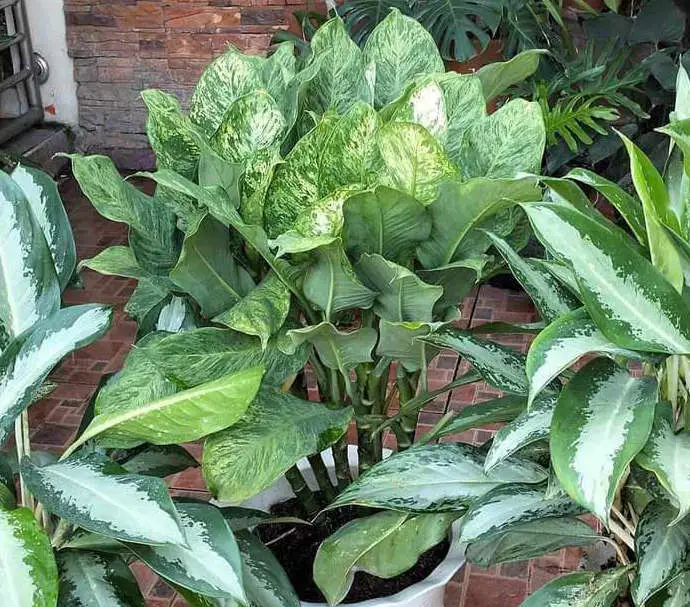The calathea plant is a beautiful, exotic-looking houseplant that can be grown in many different areas of the world. But if your leaves are starting to curl, it may be time for some troubleshooting!
There are a few things you should check before assuming this is a problem you can’t solve. Read on as we discuss what might cause curling calathea leaves and how to fix the problem.
Why Are My Calathea Leaves Curling?
Your calathea leaves are curling because it is likely that you are given them the wrong amount of water. Calathea plants hate soggy soil. If the leaves are curling, it is likely that you have over-watered your plant and allowed water to accumulate in its pot.
The other cause for calathea leaf curling could be related to temperature. The optimal temperature range should run between 60-75 degrees Fahrenheit, so make sure it falls within that range, and try not to place them in areas that experience cold wind or dry heat.
How Do I Stop My Calathea from Curling?
You can stop your calathea leaves from curling by attacking the root cause of the issue. Here’s how to do that:
Calathea leaves curling from overwatering
The first step you should take in this case is to stop watering your plant as frequently. It’s important to let the soil dry out for a week or so before watering again.
When it is time for another drink, make sure the water drains from the bottom of the pot. In fact, using a pot with drainage holes is very important.
You may also want to make sure the soil is well-draining by adding some perlite to the mix. This will help the water escape, instead of pooling at the bottom.
If you need help with identifying how often your calathea needs water, consider purchasing an electronic moisture meter that gives accurate results. This is the best way to avoid any future problems with watering your calathea.
If those steps don’t work then move on to pruning or repotting your calathea plant. The roots might be rotted due to overwatering, so they won’t absorb as much water as they should. Simply use a pair of sterilized scissors to cut off any mushy or rotting roots.
Calathea leaves curling from underwatering
This is typically shown by leaves that curl inwards, which is done to trap as much moisture inside as possible. The best way to stop your calathea from curling due to underwatering is by giving it a good soak.
You should soak the entire plant in a bucket of water and let it sit for about 30 minutes.
After that, be sure to drain all excess moisture from your calathea’s pot before placing back on its decorative tray. The last thing you want is stagnant water sitting at the bottom of your planter! If this happens, the roots will rot and eventually cause irreversible damage to your beloved houseplant.
Calathea leaves curling from heat stress
If extreme heat is what’s causing the leaves of your calathea to curl upwards, you should take steps to cool down your calathea. The best way to do this is by moving it somewhere with lower temperatures and more shade – like an eastern-facing window or under a plant cover (for example, using the Sunbrella fabric).
If you don’t have access to either of those options then simply move your potted calathea outdoors for some fresh air. Just make sure that’s only during cooler months – if left outdoors during peak temperature, even when shaded, there is still a possibility that your leaves will burn!
The bottom line? Calatheas are beautiful plants but they require certain conditions in order to flourish. It might be difficult at first getting used to caring for these specific types of indoor plants but if you follow the steps laid out here, it should become second nature in no time!
Calathea Leaf Curling FAQs:
Calathea plants are complicated. As such, you may have a few more questions about curled calathea plants. Hopefully, the following frequently asked questions will help you!
Should curled calathea leaves be pruned?
No, there is no need to prune your curled calathea leaves. Calatheas are slow-growing, so it’s best to just keep an eye on the curling problem and only remove damaged leaves if they are dead.
Will curled calathea leaves uncurl?
Yes, as long as the cause of curling calathea leaves has been dealt with, they should uncurl. If you’ve corrected issues such as root rots or underwatering then over time your plant will recover and its leaves may stop curling!
Is curling calathea leaves a sign of disease?
Curling calathea leaves are usually the result of overwatering or underwatering. This curling isn’t a sign of any type of plant disease, so it doesn’t need to be treated as such.
Is curling calathea something to worry about?
Curling calathea leaves are a sign that something is wrong with your plant. However, curling isn’t too much of an issue if you start following the basic care guides for calatheas.
Do I need to repot my curled calathea?
Only if you suspect your calathea is suffering from root rot. If not, avoid repotting your calathea plant since you can cause unnecessary stress to your plant.
Curled leaf tips have turned brown; what do I do?
Browning at the ends of curled leaves is a sign that your plant might be getting too much water (or may already be rotting), in which case you should follow the advice listed above for stopping over-watering.
If you can also identify signs of root rot, then simply repotting into fresh compost to save the plant.
Conclusion
In conclusion, if you’re wondering why your calathea leaves curling, it’s most likely due to one of three main causes. Make sure that your plant is receiving the right amount of water and that its humidity range falls within acceptable limits, make sure not to overwater or underwater, and don’t place in drafty areas.
Moving forward, it’s important to give your plant the correct care for its needs. This means looking up your specific variety to see what temperature and humidity range it needs, as well as the amount of water that it requires.
The most important rule is to only give water when the top inch of soil is dry. You can test this by dipping in your finger or using a moisture meter.
I hope that this article has helped you understand why your leaves are curling and what steps to take to fix them.
Tim is an avid gardener from the UK. He was the founder of PlantCarer.com from 2021 to Sep 2023. He sold PlantCarer.com to Aaron. He has since started his own business called Seed To Supper, which provides new gardeners all the materials you need in a box (pots, seeds, compost and instructions) to grow your own delicious and nutritious vegetables and herbs from start to finish – no garden required.






0 Comments